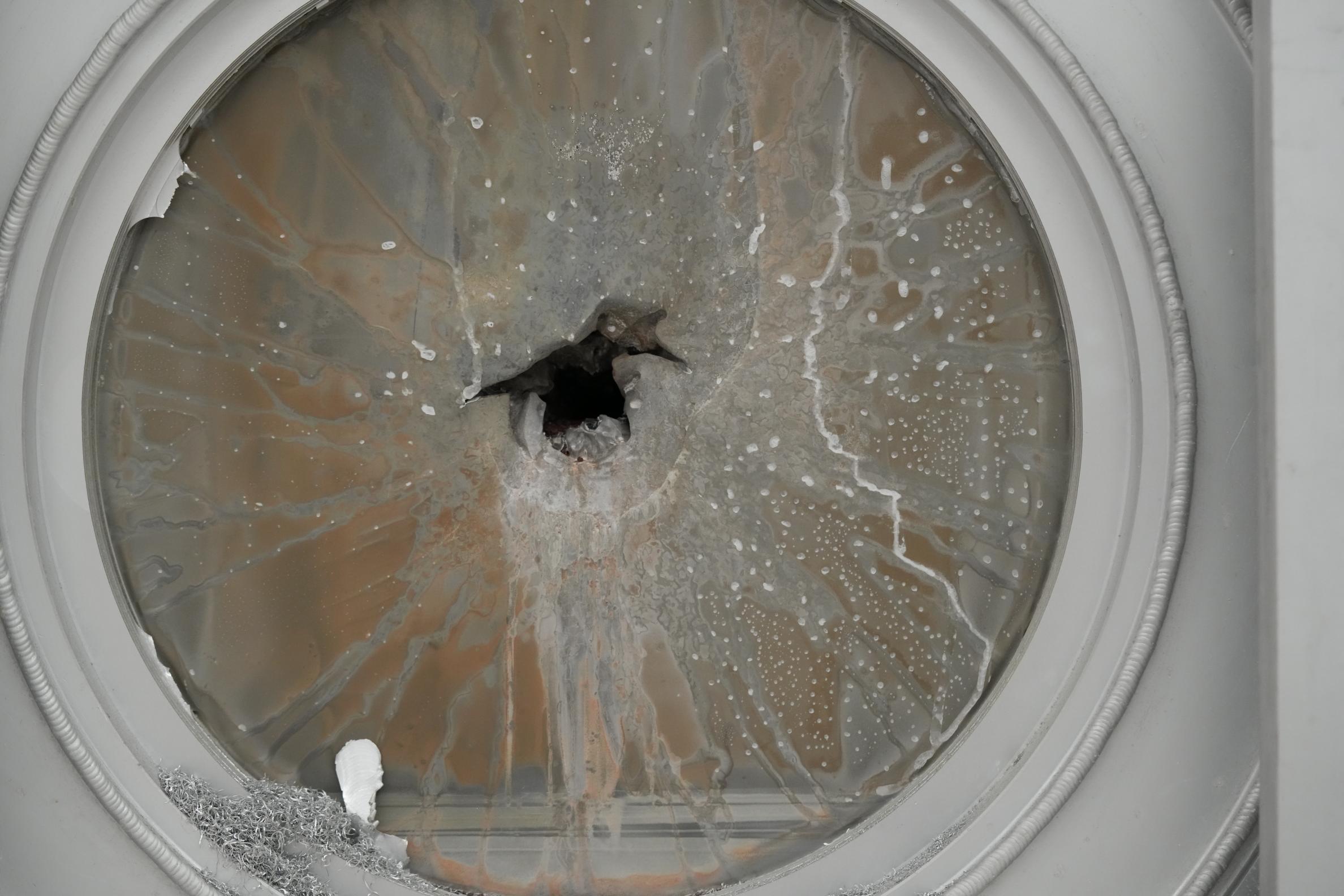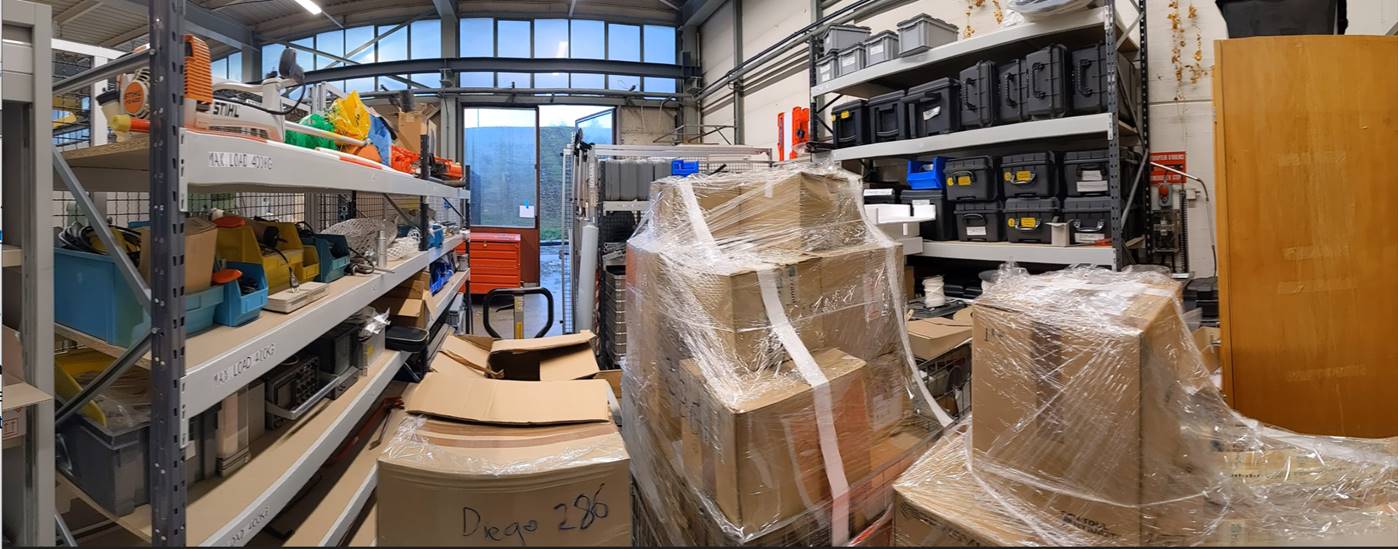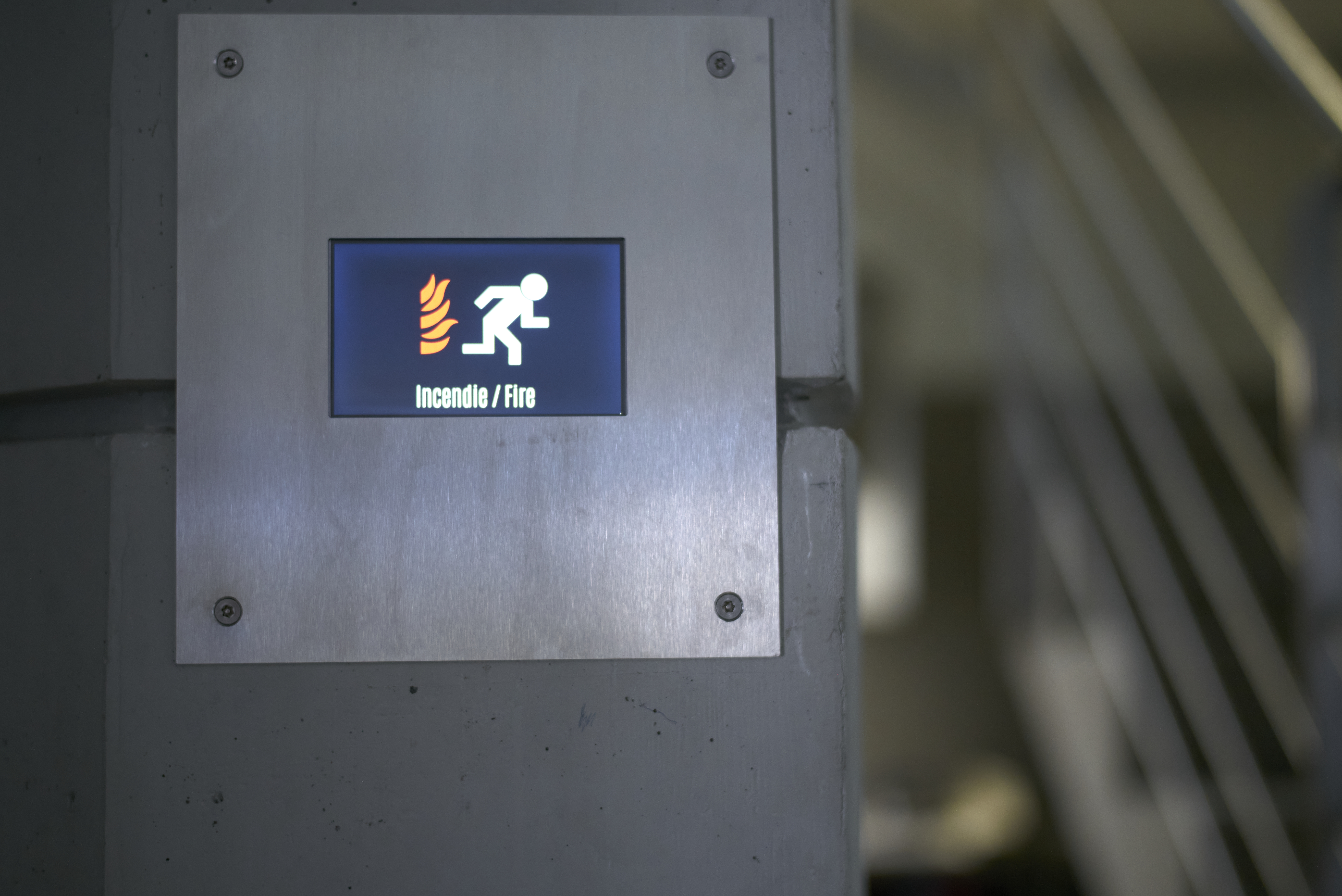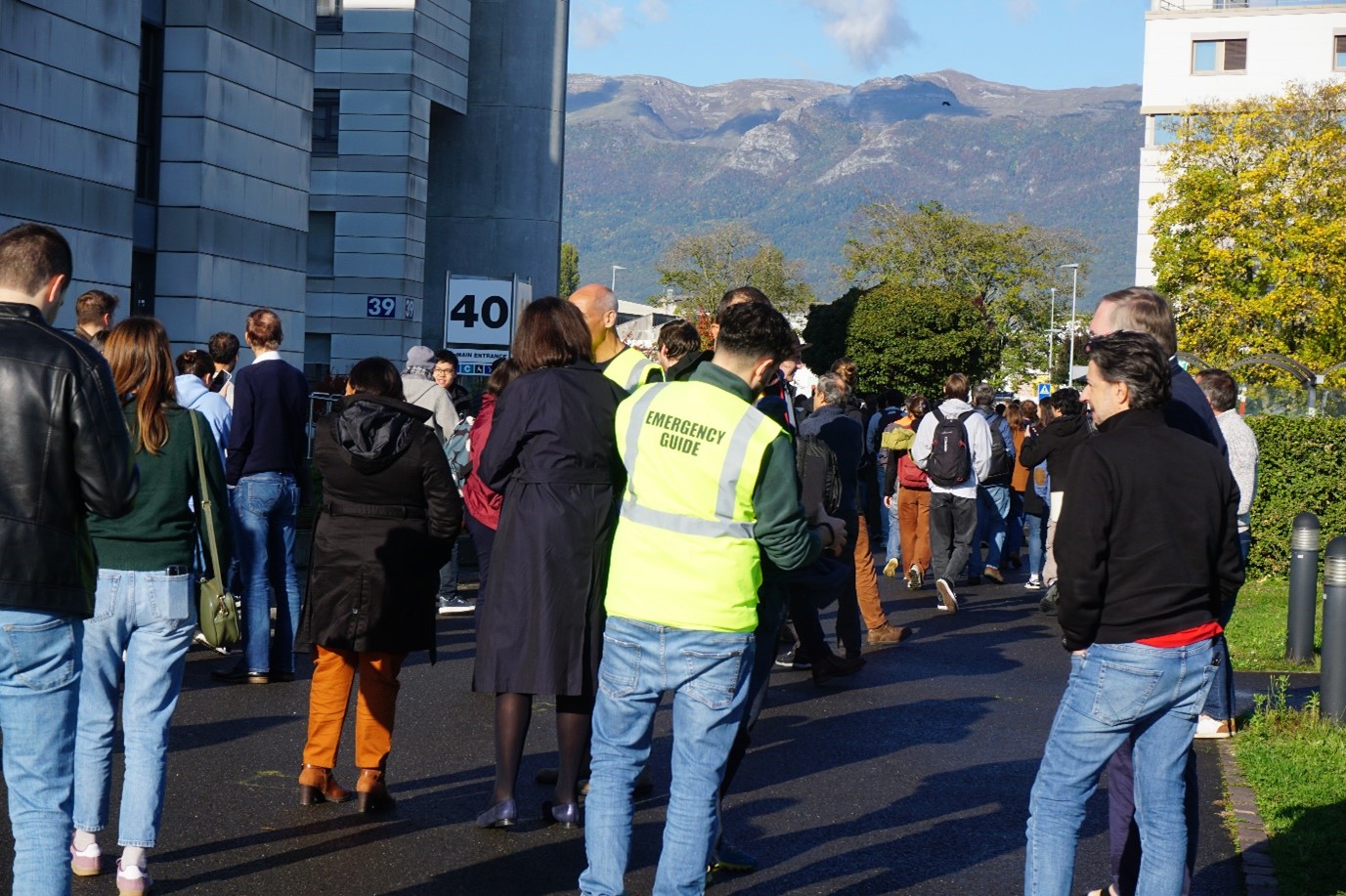
December 2024
Welcome to the HSE Newsletter, which is published at least twice a year and features some selected highlights for the HSE Unit. You can find the other editions here or in the side menu.
We thank the contributors and encourage anyone who has a newsworthy story to share it with us at hse-comms@cern.ch. We will then publish it on the most appropriate channel, including the CERN Bulletin or the HSE website.
A PDF-version of this newsletter is available on EDMS.
Happy reading!
Contents
- Unusual fires and unusual installations call for unusual intervention means
- Challenging regulations: added burden, or added value?
- Thinking outside the (Radioactive Waste) box to future-proof hazardous waste disposal
- Les “Jeunes reporters pour l’environnement” au CERN
- Finding a home for CROME
- CFRS become environment trailblazers
- Electrical safety inspections explained
- I heard the fire alarm, but I was on a call...
Unusual fires and unusual installations call for unusual intervention means
CERN conducts Compressed Air Foam Systems (CAFS) Suppression tests for fire safety
CERN’s unique installations present many different risks and particular constraints for fire safety, especially in the labyrinth of underground facilities and long accelerator tunnels. Firefighting response strategies must be tailored to these specific challenges.
Click to see how CFRS keep on innovating
Finding the right medium to extinguish fires in complex environments is a continuous challenge: new solutions are regularly assessed by the CERN Fire and Rescue Service (CFRS) to determine their relevance for CERN’s installations. In this vein, Compressed Air Foam Systems (CAFS)—which are already in use to some extent alongside traditional fire extinguishing means—were identified as a promising candidate for wider deployment in particularly challenging environments. Validating the choice to deploy the solution widely required extensive testing, so CFRS teamed up with the HSE-OHS Fire Safety Engineering (FSE) team to carry out a series of fire suppression tests using CAFS.
Why test CAFS?
CAFS is a firefighting tool that combines compressed air with water and foam concentrate to create a foam that is more effective at suppressing fires by coating and cooling surfaces, while using less water. CAFS present many advantages over the usual use of water to extinguish fires, with a marked reduction of water usage, property damage, air and water pollution, and less off-gassing (the release of harmful gases). CAFS mobile systems can be strategically placed for rapid deployment. Without the need to set up hoses, these mobile systems enable quicker response over long distances, speeding up reconnaissance and fire suppression. Further, the elimination of hose deployment reduces physical strain on firefighting teams and can shorten clean-up time, leading to faster recovery.
Why are these tests essential and what was their objective?
CAFS have already been deployed at CERN for fire suppression, particularly in challenging underground environments. However, despite prior studies, the performance of CERN’s CAFS had not been thoroughly tested on-site. This full-scale testing campaign aimed to fill that gap, comparing the CAFS to traditional water-hose approaches and other methods like compressed air water (CAW) in real conditions. The main criteria were to measure extinguishing time and extinguishing agent consumption.
Concretely, the tests were designed to simulate potential fire hazards, such as those involving electric cables, transient fuel, or electronic cabinets, to ensure that CAFS were effective for such medium size fires, specifically those reaching up to 5MW (comparable to a large car fire). CAFS would serve as an intermediate solution between CO2 extinguishers, which are effective for smaller fires up to 0.5 MW (equivalent to a garbage bin fire), and conventional water hoses, which can manage large fires exceeding
5 MW.
What did the campaign entail?
Tests took place at the Prévessin Safety Training Centre and Zone 19, and involved a multidisciplinary team of fire safety engineers, firefighters, and summer students. Over 10 days, more than 33 tests were conducted, burning over 240 pallets and electronics equipment at two locations, one indoors and one outdoors. Different firefighting techniques were tested and compared, including water, CAF, and CAW, with detailed measurements (such as heat release rate (or fire power), time to extinguish and extinguishing agent consumption) collected throughout the process.
Looking ahead, what are the results and next steps?
The tests demonstrated that the CAFS were highly effective, successfully extinguishing all fire scenarios tested. In the most extreme set-up, CAFS used up to 85% less water than conventional water-based methods. The system is already in operation in the SPS and the LHC, and it will soon be deployed in the North Area. The team also aims to present the test findings at the Interflamm 2025 conference and submit a paper to a peer-reviewed Fire Safety publication to demonstrate CERN’s proactive approach to modern fire safety techniques.
This testing campaign is yet another good example of first rate, truly hands-on HSE cross-group collaboration: it underscores CERN's commitment to cutting-edge safety practices, to ensuring the protection of its infrastructure while minimising resource use and environmental impact.
And as a picture speaks a thousand words, see the team in action below!
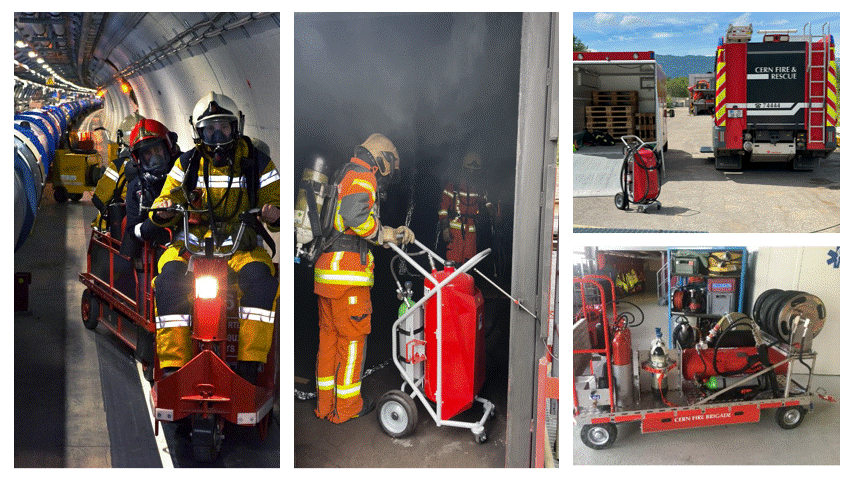
Challenging regulations: Added burden, or added value?
Soil management: how could going the extra mile to manage waste possibly add value for CERN and its busy contractors?
Click here to find out
On a rainy winter morning in early 2024, Jean-Paul Bergoeing from ENV-EP is putting on a mud-splattered high visibility jacket and boots. He has delivered a presentation to SCE colleagues and contractors about soil management on a new worksite and is about to go and demonstrate of how they can implement the teachings in the field.
“In general, CERN aspires to follow the best practices in matters of environmental protection” he explains. “In Swiss law, there is a whole set of rules relating exclusively to soil on worksites. if you follow the advice, it gives you really great results”.
As for all matters of safety, CERN aspires to follow the very best practice in environmental protection matters. This implies reviewing French and Swiss legislation and applying the one with the best environmental standards. In this case it is the Swiss legislation that is the most complete.
|
Jean-Paul knows all too well that this can cause challenges with worksites located in France, especially as many contractors are not familiar with the detailed Swiss practices. He explains what it means in practice: “Both contractors and most project managers see it as a burden at first. Their focus is on the building and its technical aspects, not on the soil. They think it will make it more time consuming, more expensive, and that finding contractors willing to comply will be difficult. “This is especially the case with our worksites located in France, i.e. most of them: site workers always ask why we need to follow Swiss practices if we are on French territory. That is why it’s essential for me to get out in the field.” |
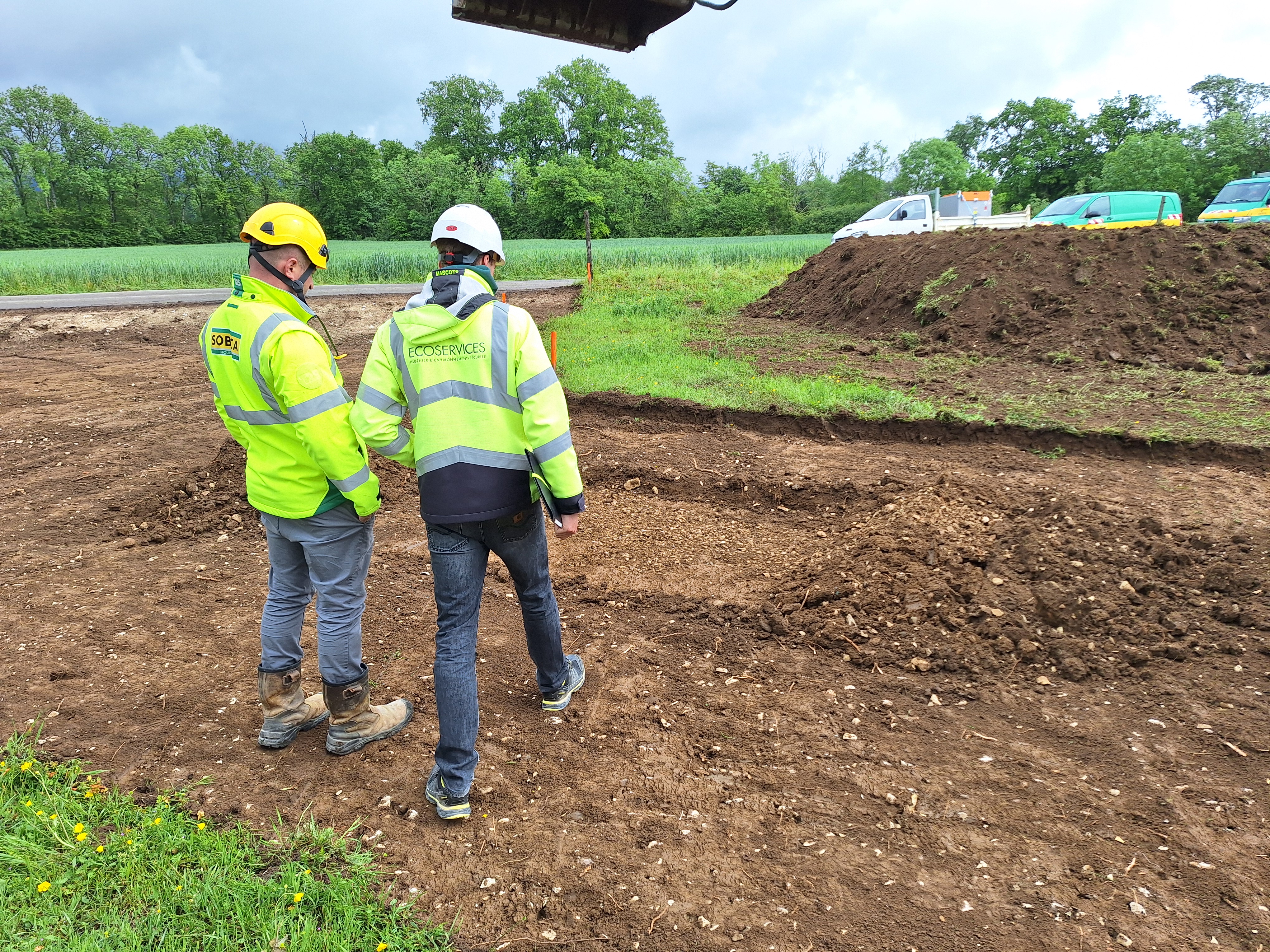 |
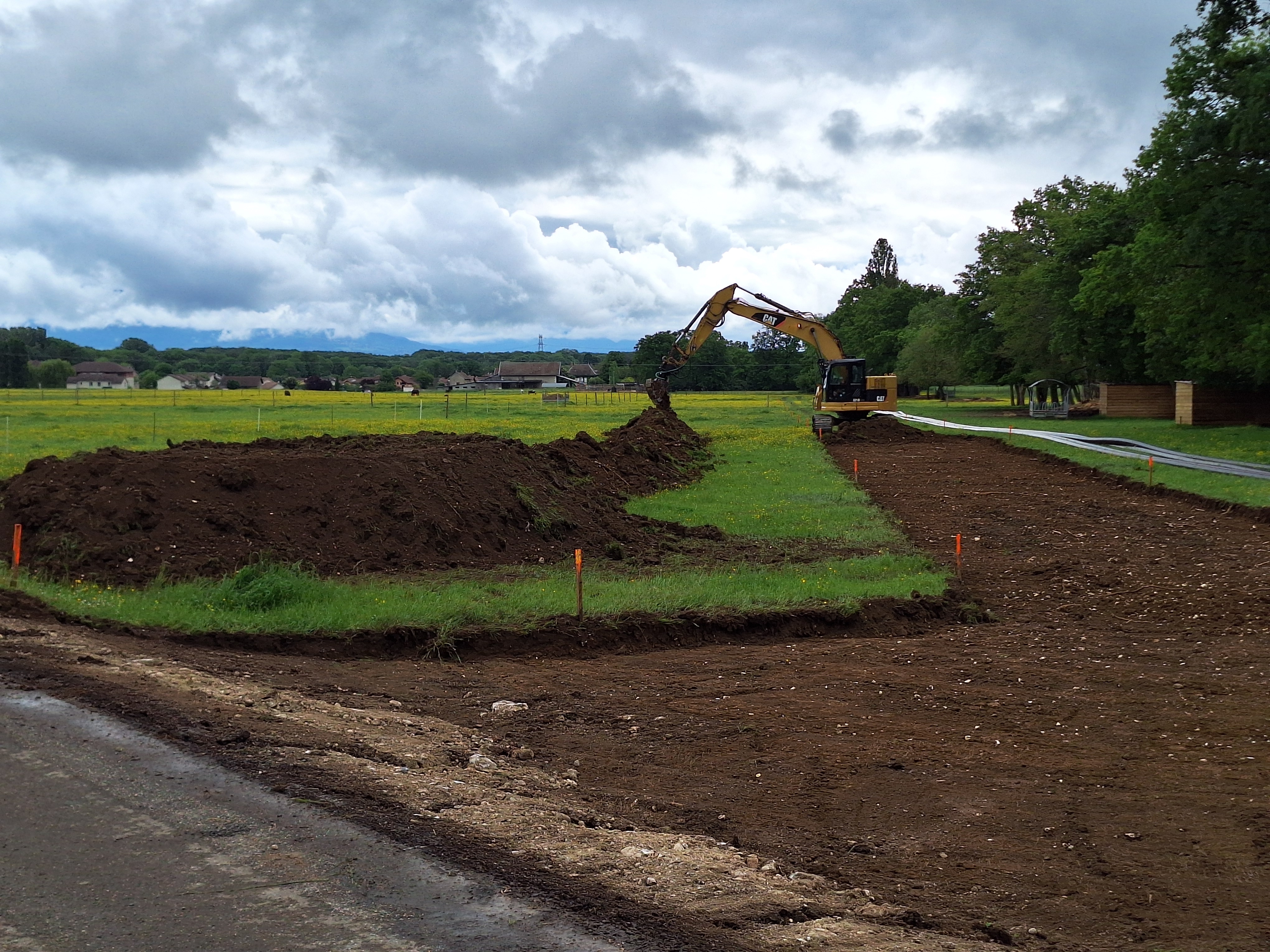 |
When we present safety practices in an office, people see us as bureaucrats. But when I show up on-site, muddy boots and all, they listen," Jean-Paul explains. Through hands-on engagement with contractors, he has seen a significant shift in attitudes toward soil management, with one recent project serving as a prime example. As part of CERN’s work to upgrade power infrastructure around the LHC, a 66kV cable trench—over 5 km long and nearly 2 metres deep—is being laid through farmland in the Pays de Gex. This high-stakes project in collaboration with SCE could easily disrupt the region’s valuable topsoil, which takes millennia to form and is essential for local farmers’ livelihoods. Understanding the risks, Jean-Paul joined the worksite from day one, collaborating with contractors alongside a Swiss soil specialist to demonstrate Swiss soil protection practices. "It wasn’t an inspection; it was a partnership," Jean-Paul says. "The contractors responded well, especially seeing me in the mud with them. Soon, they were not only following the soil practices but also teaching them to newcomers." This collaborative approach ensured the project ran smoothly, to the relief of both CERN and local farmers. The impact went further—one contractor later reported winning another project thanks to these practices they learned with CERN. |
“Indeed, as effective as these soil protection measures are, I would argue that the positive collaboration between the different CERN services involved is just as important for ensuring the best outcomes for the environment and our stakeholders.
“The collaboration of SCE, and their willingness to listen and work with us on this project is what has created this fantastic result for CERN and our contractors. If we had been left out of the loop or treated merely as a compliance body, rather than a guide, then none of this could have been put in place.
Jean-Paul emphasises that it’s not just about following guidelines but creating partnerships that benefit everyone. "What CERN achieves here goes beyond compliance; it’s about sharing knowledge. Good environmental practices support people and businesses, and that’s what our work is truly about."
Thinking outside the (Radioactive Waste) box to future-proof hazardous waste disposal
When a key experiment piece failed to fit inside its radioactive waste container, RP saw an opportunity to collaborate with SY on an autopsy, sharing information which could help the Organization for decades to come. But what they found was even more surprising than they could have imagined…
Click to see more
We have all experienced it: a piece of waste which does not fit in the bin, and needs to be squashed, folded or broken up to get the lid back on. Imagine, then, that you need to do this to a two-tonne block of highly radioactive metal, which had been taking PS beam for almost ten years.
Can you imagine that such a process can lead to interesting discoveries for the future?
Gérald Dumont, Section Leader of the Radioactive Waste Management Section in the RP Group, and Fabio Pozzi, Radiation Protection Responsible for ‘neutron Time-Of-Flight’ facility, or n_TOF, explain what happened when they tried to eliminate a target for n_TOF towards a repository in Switzerland.
Gérald explains: “under the tripartite agreement we send certain radioactive waste to Switzerland for its safe disposal. The waste can only be packaged in containers of a certain size, as required by the Swiss authorities, and sadly this target was too large for the Swiss container.”
As the target owners from the SY Department wanted to carry out an autopsy of the object. RP decided to work together, following the example of the LHC beam dump autopsy (see the ‘In Focus’ in the 2021-2022 Environment Report’s Waste chapter).
“The target is the critical component of the n_TOF facility” says Fabio Pozzi. “It is only replaced every ten years or so and its material composition can significantly affect the range of experiments that physicists can do in n_TOF.”
The targets must remain reliable over long time periods of continuous beam exposure. But they also need to be efficient at converting the beam into neutrons with the range of neutron energies physicists require. The autopsy was planned by SY to improve these target characteristics. At the same time RP saw an opportunity to improve the end-of-life design and facilitate future disposals.
Increasing the lifetime of these targets, thus reducing the amount of radioactive waste CERN produces overall, is a strategic objective for CERN.
|
In addition, the target in question was an odd shape, so RP had no choice but to cut it down to size in order to send it on for disposal. This is something that should be avoided, whenever possible, in the future. Indeed, as the target had become highly radioactive its safe handling was a major challenge for operational radiation protection. In order to cut the device down, an ad-hoc secure facility was created where any contamination produced could be contained. The project team then had to explore the feasibility of using CERN robots (operated by BE-CEM) to perform the work to minimise the time spent by people next to this radioactive object. |
|
|
Finally, the autopsy produced a surprising result. There was a hole in the target where the beam had entered. It looked as if it had completely melted through the face of the lead target, leaving a deep cavity. This is not something the team had seen before on this scale and the reasons are not yet fully known. “This has been an interesting project” says Gérald. “SY, RP and the n_TOF community continue to profit from each other’s expertise. SY have learned a great deal about target design and are more aware of our needs for the radioactive waste management.” He concludes that there is much to learn from used experiment pieces and hopes that autopsies are carried out more routinely in a dedicated facility somewhere on the CERN site in the future. |
Les “Jeunes reporters pour l’environnement” au CERN
Le jeudi 30 mai 2024, jour de la course de relais annuelle du CERN, alors que les nuages s’accumulaient dans le ciel annonçant une bonne averse, le soleil était bien présent dans la salle Andersen du bâtiment 40 où quelques dizaines de lycéens du Lycée Saint Stanislas de Nantes présentaient leur travail dans le cadre du projet « Jeunes Reporters pour l’Environnement » et du concours international « Youth Climate Report ». Les sujets étaient divers et passionnants, les étudiants enjoués et motivés et surtout enchantés de pouvoir montrer leur travail au CERN, lieu mythique à leurs yeux.
Cliquez pour lire leur histoire
Cette visite a été organisée par Yann Donjoux (DPO de HSE) qui déjà en 2014, en partenariat avec le CEPN, avait organisé les rencontres lycéennes internationales de la radioprotection, au CERN : trois jours, plus de 200 étudiants issus de 16 lycées français différents pour des échanges riches et intenses.
Yann est resté en contact avec les différents lycées, mais c’est avec l’établissement Saint Stanislas de Nantes et les professeurs de Science de la Vie et de la Terre (SVT), notamment Sabrina Neveu que la collaboration s’est poursuivie cette année. Fabrice Malacrida (HSE-RP) a rejoint Yann dans l’aventure des lycéens nantais, en acceptant de les suivre sur l’année dans leur projet pour aboutir à cette belle conférence où les jeunes ont pu présenter leur travail aux professionnels du CERN.
Après une introduction par Sonja Kleiner, cheffe du groupe HSE-ENV, sur le CERN et de l’environnement, puis une présentation de Fabrice sur la « Surveillance et protection de l’environnement d’un point de vue radiologique », les étudiants ont pris la parole en présentant des thématiques très diverses : les transports électriques, la Fast Fashion, l'alphathérapie pour le traitement du cancer et la résilience de la faune face aux accidents nucléaires.
Sabrina Neveu s’est dit « impressionnée et très fière de leur travail. » Yann a également souligné la qualité de leurs interventions, de leur approche, leur conviction et leurs réponses aux questions.
Quant aux étudiants, qu’ont-ils retiré de ce parcours ? Gabrielle a bien résumé le ressenti : « tout a été super intéressant. Quand on est arrivé dans cette classe on ne s’attendait pas à vivre tout ça, mais finalement c'est extraordinaire et c'est une expérience géniale. On a rencontré plein de gens, on a pu apprendre plein de choses. » Et Maxence d’ajouter, « ce qui m'a le plus plu, c'était justement d'être avec les experts, de voir que pour une classe de Seconde générale, parce que le sujet intéressant et que les gens sont motivés, ils sont prêts à nous passer plein d'infos, à se casser la tête pour que ça soit plus clair pour nous, plus simple. Ça, ça m'a vraiment plu. » Et pour Martin, « visiter des endroits qui sont, comme le CERN, uniques au monde, c'est une chance inestimable. Et comme j'aime beaucoup la physique, ça me plaît beaucoup d'être ici. »
La journée s’est poursuivie avec des différentes visites pour terminer en beauté avec un repas et une partie de bowling.
Yann a été ravi de cette journée : « Cet évènement est sans aucun doute l’un des plus beaux que j’ai organisé, en raison de l’ambiance particulière qui a régné durant ces quelques jours. J’ai trouvé ces jeunes extrêmement motivés, désireux d’apprendre. Avoir des jeunes d’une filière générale est sans aucun doute un plus par rapport à des jeunes déjà conquis par les sciences. »
Pour voir toutes les vidéos et présentations, consultez l’évènement INDICO.
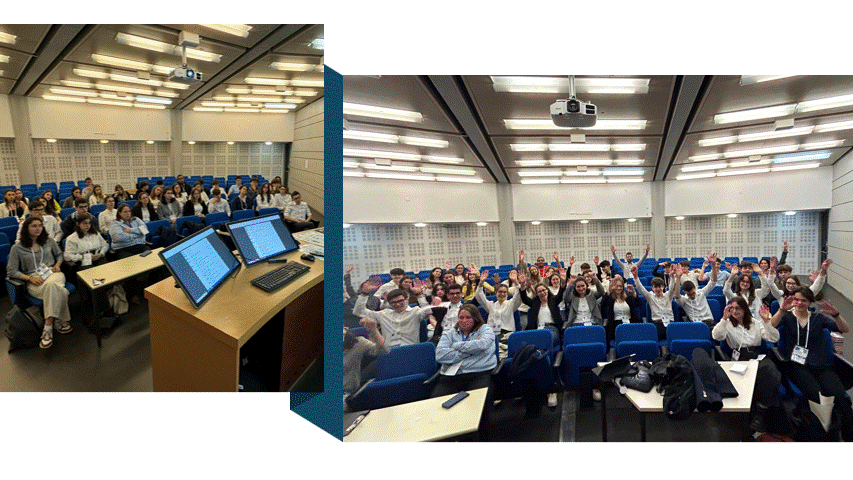
Finding a home for CROME
If you thought electronics was all about tinkering with wires and circuit boards, think again! As Daniel Perrin’s RP-IL team discovered, sometimes challenges at work lie in unexpected corners and require a whole host of new skills to meet them. This is what they faced when they had to find a new space for their workshop to mass-produce CROME devices, their next generation radiation monitors.
Click here for the full story
Space is a scarce resource at CERN, and everybody likes to keep hold of what little they have. We met with Daniel, alongside Paula Correia (Departmental Space Manager for HSE), Michel Pangallo and Gaël Ducos (two RP-IL engineers working on CROME) to find out exactly how challenging it is to set up a small, but suitable workshop for mass producing cutting-edge electronics.
Q: First of all, tell us why you needed a new workshop. Do we not already have a lab in B6154?
Daniel: Yes, we do have an electronics workshop for prototyping and small-scale production in B6154. However, before LS3—when we will upgrade the radiation detectors from Linac 4 to the LHC and associated experimental areas—we need to produce literally hundreds of CROME devices, all with their associated power supplies and processing units.
Michel: Each CROME system is a collection of five or more individual devices. The sensor, the processing unit, special cables to carry the signal, a power supply, and the alarm unit. This means more than a thousand of individual devices need to be made and tested for this project. B.6154 was built for the ARCON replacement project, which required 250 CROME systems, and it was too small even then.
Daniel: In the current workshop, we could make maybe ten units of CROME a week, if we really tried. But it would not be very pleasant. To meet the deadline, we need to produce at least double that or more. We therefore needed the space for multiple technicians to work in parallel, and in a suitable environment to keep the high-sensitivity electronics safe.
Q: What specific needs did you have?
Gaël: Because CROME needs to measure such tiny amounts of radiation, but also have the ability to detect very large amounts in some areas or in an incident, its electronics are extremely sensitive.
We need the standard protection measures you would find in any workshop for electronics, such as antistatic floors and workbenches, and a low-dust environment to ensure high product quality. But we also needed a space with consistent temperature and humidity, in which to calibrate the sensors, as this can have a big impact.
Daniel: When we were testing the long-term stability of some of the devices which are now fitted in the North experimental area and certain machine tunnels, we found that whenever somebody stepped on a creaky floorboard in the corridor of one of our prefabricated buildings, the CROME sensors would detect this and register erroneous values. They’re that sensitive!
Q: So how did you find an appropriate space?
Daniel: After exploring a number of possibilities, including a rental outside CERN, we managed to find an old unused building on site.
Paula: Thanks to the support of the space management community, we were able to secure the space for the project. This took a little time, but it is a good example of negotiation and collaboration between the various stakeholders in space management.
|
The building was a disused unit in the ISR area, full of old equipment. Part of the interior was fenced off and there were even weeds growing through the roof from the outside. It was in a real state. We knew right away that this space wouldn’t be suitable without major renovations. We didn’t have the budget to overhaul a whole building, but we did have some inspiration from another workshop in almost the same location. They had also faced challenges with the cost of renovation, so instead they built a building within a building! |
|
The outer warehouse was watertight, it had electricity and water, so we took this as a protective shell. Then inside we designed a workshop which had its own sealed, controllable environment, including anti-static surfaces and air conditioning to control the temperature and humidity.
We obviously cut down the weeds and completely cleared out the space whilst we were planning the build.
Q: So you literally built a new workshop from scratch, inside this building?
Daniel: Yes! Within the warehouse, we treated this as a new build rather than just a room. It did cost quite a lot, but nothing in comparison to a long-term rental. So we saved costs, but it did have to go to a competitive tender.
This meant I had to get to know the contracting process for these builds, and again, I needed Paula’s expert help with this.
|
|
Together, under the watchful eyes of Michel and Gaël, we created a 60-page technical specification which defined the scope of work for the contract. It took months! The final document was only ready in November 2023, when we took it to tender and found a good contractor. Thanks to their efforts, we were ready to start installing the workshop by the end of April 2024, and production launched at the beginning of June. Significantly sooner than we had thought. |
Q: And has the new building lived up to expectations?
Gaël: The space is excellent, the electronics space is just what we needed. The larger workshop has allowed us to take on an extra technician to help with the production. This has made a significant difference.
Daniel: This is a real success story and a very good example of teamwork across HSE but also more generally across the CERN community.
To watch a CROME alarm unit assembly and testing, watch this video.
CFRS become environment trailblazers
Thanks to the work in the HSE Operational Response project's work package 4, “Environment and asset emergency response”, CFRS are honing their skills to be best able to respond to environmental emergencies without external assistance, developing full autonomy to protect the environment, 24/7/365.
Click here for more
 |
A key work package within the HOR project aims at future-proofing CERN’s ability to protect the environment in the event of a significant environmental emergency, such as a chemical spill, fire, or any other unsuspected environmental incident. Sabrina Schadegg’s ENV-EP team have been collaborating with the CFRS to update an existing protocol adding new exercises to ensure CFRS are trained and able to respond to environmental threats at CERN even when there are no ENV experts present on site. Fire officer Jean Audrain describes the challenge: “obviously environmental protection is a huge and specialised domain. How to contain that amount of knowledge in a procedure which is effective, but not overwhelming for our responders is quite a task.” “We need a procedure which works for 90% of predictable accidents, but also doesn’t limit our ability to respond to the remaining 10% of unforeseeable situations, where we need to use appropriate skills and knowledge to adapt to something new.” |
|
Outside CERN, the idea of an environmental procedure for a fire and rescue service is unusual, as traditionally external agencies would take the lead on an environmental incident. Sabrina Schadegg says, “CERN is unique in this respect. The CFRS might be the only service in the Geneva area which is able to respond autonomously to alarms related to environmental incidents.” “Some of CERN’s facilities are quite old and small-scale environmental incidents can occur given that collective retention measures, such as centralised retention basins before water outlets into rivers were not systematically integrated in the original design. This means that the CFRS are more likely to need to intervene in small-scale incidents than a municipal fire service. Elsewhere these small issues would be managed by an environment agency, with fire services intervening only for serious problems.” The procedure not only implicated ENV and CFRS, but also required input from the CERN Control Centre team who receive the alarms. The new procedure, developed over two years, was put to the test this summer in a large-scale exercise. |
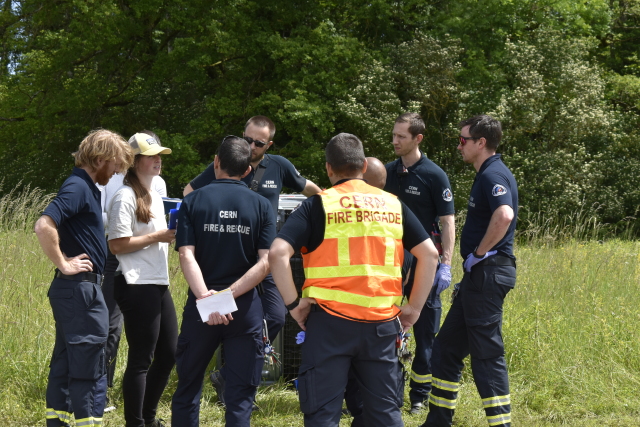 |
“It showed that we had a very effective procedure in place as a starting point and gave us the insights we needed to make it even better for all the stakeholders and responders involved. With the huge added positive point that now every firefighter knows everybody on the ENV team, with great relationships fostered ensuring we are all the more effective when we do work together”, Jean explained.
Anastasiia Ovdiienko, who coordinates the administrative support of the HOR project, also collected feedback during the exercise to continue to develop and improve the protocol in line with the wider aims of HOR work package.
“Anastasiia’s perspective was invaluable when developing the protocol and training”, Sabrina says. “She made sure our communications were accessible to non-experts, and I thank her for her invaluable help in removing all the unnecessary ENV/CFRS jargon and getting straight to the key action points.”
Anastasiia herself summarises the outcome of the project most clearly: “We don’t have many serious incidents at CERN. But with the protocol and relationships we have developed, I feel like we are now ready for anything.”
The new protocol, part of HOR work package 4 “Environment and Asset Emergency Response”, will continue to be refined in view of its integration by the time the HOR project concludes next year.
Electrical safety inspections explained
The mission of the electrical safety team in the OHS Group is to provide advice on the design, manufacturing, installation and testing of CERN’s electrical equipment and distribution network with a view to achieving compliance with the applicable CERN Safety Rules and standards.
An important task of the team is to inspect CERN's electrical installations, identifying potential hazards and preventing incidents, always remaining by the side of the technical teams to provide support and advice along the full lifecycle of an electrical installation.
Each year, around 1000 surface buildings and barracks undergo electrical inspections, according to availability, covering an impressive 665,000 m2 which corresponds to approximately 90 football fields! Further, when the physics planning allows, electrical inspections are performed along 68 km of tunnels and service galleries—equivalent to the distance between CERN and the centre of Lausanne—numbers which clearly demonstrate the scale of interventions.
To find out more about this important process, we caught up with Maria Papamichali and Igor Neuhold who answered a few questions on behalf of the OHS electrical safety team.
Click here to see what they said
Maria, can you tell us what types of electrical inspections are performed?
Maria: Electrical inspections follow a systematic process established in 2008. This includes initial inspections, carried out for each new or modified electrical installation upon request by the responsible party, and periodic inspections, scheduled annually for buildings with electrical installations presenting non-conformities, and every two years for buildings with installations free of non-conformities.
What type of electrical installations are inspected?
Maria: We inspect extra low voltage, low voltage, high voltage installations, industrial and experimental installations and also intervene in events such as the Hardronic Festival and CERN’s official events, including most recently the CERN70 celebrations.
Igor, what is the regulatory basis for performing Electrical Inspections?
Igor: The regulatory framework for electrical safety at CERN is currently described in Safety Code C1, complemented by the Safety Instructions IS 24, IS 48, IS 5 and Safety Guideline SG EL-0-0-1. Electrical inspections are performed based on these regulations and according to the Safety Instruction IS 4. It should be noted that these rules will soon be revised as part of the HSE branch of the Electrical Safety Project, led by Christophe Delamare in the TS Group.
Who performs these inspections?
Maria: For initial and periodic inspections, the work is mainly carried out by contractors on service contracts managed by HSE. For non-standard installations, that are more complex and for urgent or critical requests, interventions are directly carried out by the HSE electrical safety team.
What type of non-conformities are most commonly identified during these inspections?
Igor: There are many! We detect some 100 non-conformities in initial inspections each year, and for periodic inspections it can reach 10 000! A few examples include absent or inadequate ingress protection (IP), exposing live components and increasing the risk of electric shock; missing grounding, increasing the risk of shock by failing to provide a fault current path; malfunctioning or absent differential protection (30 mA), reducing fault detection and increasing shock severity; maladapted circuit breakers, risking fire or equipment damage due to inadequate overcurrent protection; unconnected cables without grounding, posing hazards of accidental energisation, shock, or arc flash; and faulty or missing safety lights, obstructing evacuation during emergencies, particularly in low visibility conditions.
How are these non-conformities resolved?
Maria: For initial inspections, they are resolved by project leader of the corresponding project, and for periodic inspections, by equipment owners or TSOs. Actually, the persistent high number of non-conformities triggered the creation of the Project "ELECNCSOL" in 2021, led by Christophe Delamare of the TS Group in close collaboration with the largest concerned groups, EN-EL and SCE. This project ensures a systematic approach for the resolution of non-conformities. Once all non-conformities of a building are resolved, periodic electrical inspections are performed every two years.
How do the findings from these inspections help improve the safety culture at CERN?
Igor: The findings of electrical inspections are carefully studied and analysed. It is possible to identify trends and lessons learned that allow the electrical safety team to proactively propose improvements for specific electrical trainings, technical documentation or for future electrical projects.
What future innovations do you foresee in the realm of electrical safety inspections?
Maria: For electrical inspections to become automated! Now that the process of electrical inspections is consolidated, a new software tool—Sailor Elec, an offshoot of HSE’s Sailor tool—is under development by the TS-CS team. The goal is to automate the complete lifecycle of electrical inspections, from planning to creating reports for each building inspected. It will also include a module for the follow-up actions for resolving the non-conformities and will provide statistics and data on Electrical Inspections.
Finally, what can members of personnel do for maintaining electrical safety?
Igor: I’ve actually coined a new motto for us all in our daily work, that can be added to the better known “Don’t know? Don’t touch!”. It is: “Awareness powers safety, and education is the best conductor.’’. Everyone at CERN should always have this in mind. Anyone can support the electrical safety team by granting access to installations during electrical inspections, so that electrical tests and power cuts can be carried out. Following appropriate training is also key, with as minimum the online course Electrical Safety - Awareness - Fundamentals / Sécurité Électrique - Sensibilisation - Fondamentaux. In case you spot damaged electrical material, inform the Electrical Service concerned via the CERN Service Desk, and contact us in case of doubt: electrical-safety-specialist@cern.ch.

The electrical safety team.
I heard the fire alarm, but I was on a call..
On a sunny morning in October, the unsuspecting occupants of buildings 40 and 42 were about to become actors in one of the largest building evacuation exercises of the year. The feedback from this exercise, organised by Building 40 TSO, Marta Brasseur, and Evelyne Dho, Deputy DSO of the EP department in collaboration with the CFRS, building TSOs, and OHS, has revealed some interesting results.
Follow this photo montage to discover what it takes to make such a large-scale exercise work.
Click here for the photos
|
Sara Hansen, Fire officer at the CFRS, has one simple message to share with us after organising the evacuation: “When you hear the alarm, always evacuate, even if you are 99% sure it is a drill.” As a reminder, Emergency preparedness is one of the main Safety objectives for the Organization. After months of planning, over one hundred organisers and volunteers came together for the final pre-exercise briefing on the morning of October 10, 2024. This was led by Building 40 TSO, Marta Brasseur and Evelyne Dho, Deputy DSO of the EP department, alongside the CFRS and OHS colleagues. Take a tour of the photos below to discover what a mass-evacuation exercise looks like, what it involves and to understand why such exercises are so important in a complex organisation like CERN. |
|
|
|
Almost all HSE groups were implicated in the exercise, from monitoring the behaviour of people in the building, to ensuring that the alarm volume was sufficiently loud throughout the building. In this picture, we see Brecht Debrouwere, a fire safety expert from OHS-IB setting up a GoPro to film the main atrium of B40. As well as the organisers, almost 90 volunteer observers were placed throughout the buildings to observe behaviour and take notes. Some were asked to speak with building occupants to try and better understand behaviour, while others were asked monitor key exits and the flow of people through the building. To set up an operation on this scale without raising the suspicion of the building occupants was an achievement in itself. |
|
At 10:03 a.m., the fire alarm was triggered manually by colleagues in EN-AA. All the organisers of the exercise held their breath to see if their months of planning would pay off. After just a few seconds, the first building occupants left the building and headed to the assembly point, demonstrating excellent awareness of evacuation procedures. Many of these initial evacuees were in the restaurant area or offices close to the emergency exit routes. |
|
|
|
As more people began to leave, some crowds formed at the front of the building, away from the assembly point, as people searched for colleagues, friends, or emergency guides. This can unfortunately make it more difficult for building occupants to evacuate, and for rescue services to access the building. Thankfully, the emergency guides were able to move people in the right direction, but a valuable lesson was learned in that not everybody was appropriately experienced with following evacuation procedures. Training the majority of CERN personnel in emergency evacuation, including experience of real-life evacuations such as this, is a key target for the Organization – and a major challenge. |
|
The CFRS arrived in force, with one officer joining the building fire safety team at the assembly point to intervene in the event of known casualties or missing people. At this stage, emergency guides shared the details of their area of responsibility including any casualties, reported missing persons, or wheelchair users waiting in designated areas. |
|
|
|
The CFRS conducted a survey of the building before declaring it safe. Amusingly, they came across some building occupants who had chosen not to evacuate. Needless to say, the occupants quickly changed their minds, and these individuals were interviewed by the observers to better understand their reasoning. One said “Yes, I heard the alarm, but I was on a call so I couldn’t leave”. Changing such behaviour remains one of the main challenges in evacuation procedures. |
|
The assembly point for B40 and B42 is outside the CERN hostel and bicycle racks. By the end of the exercise there were over 500 people waiting there, including the building safety team, who gathered to debrief and share information about the experience. At around 10:20 a.m., barely twenty minutes after the alarm sounded, the building occupants were allowed to return to their work. But that was not the end of the exercise… |
|
|
|
After the exercise, all organisers and volunteers returned to the conference room to finalise their records of the event, including a post-exercise review checklist, and transcribing any interviews with building occupants. The amount of data generated by the volunteers was immense and will be processed by all the stakeholders involved. |
|
There was also an immediate feedback session, where reflections on the exercise were shared in an open forum which lasted over an hour, with all points being heard, minuted, and solutions discussed. |
|
|
|
Thanks to the fantastic work of all involved, especially the emergency guides and volunteer observers, not only will issues be addressed in buildings 40 and 42, but the data collected will help improve evacuation procedures across all of CERN’s tertiary and administrative buildings. And remember: even if you think an evacuation exercise is just a drill, it is still an essential part of our duty to learn and practice what may one day save your life. So next time you’re on a call and the alarm goes… don’t be tempted to stay online. Congratulations to the organisers, volunteers and all involved! |

